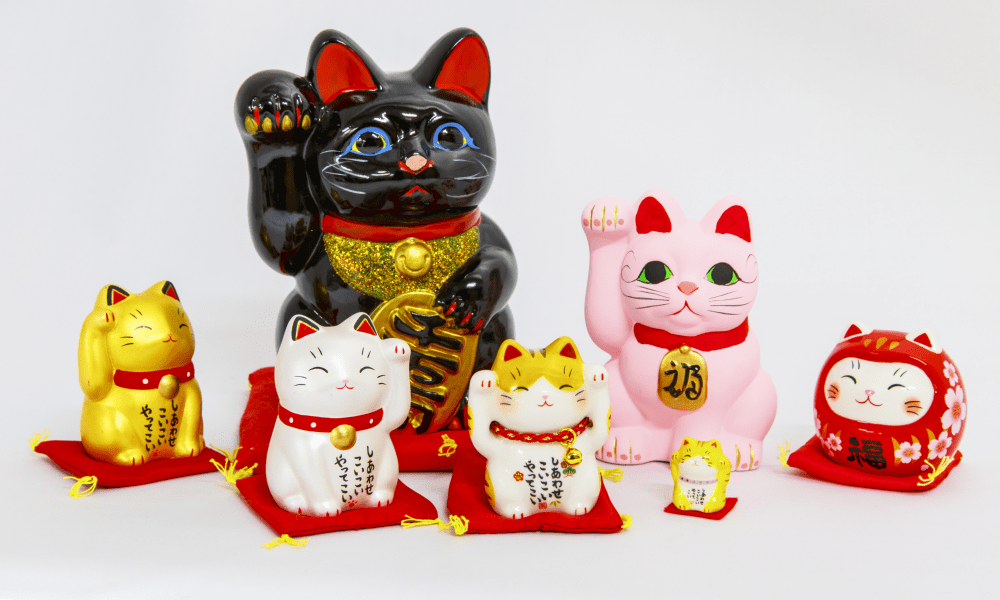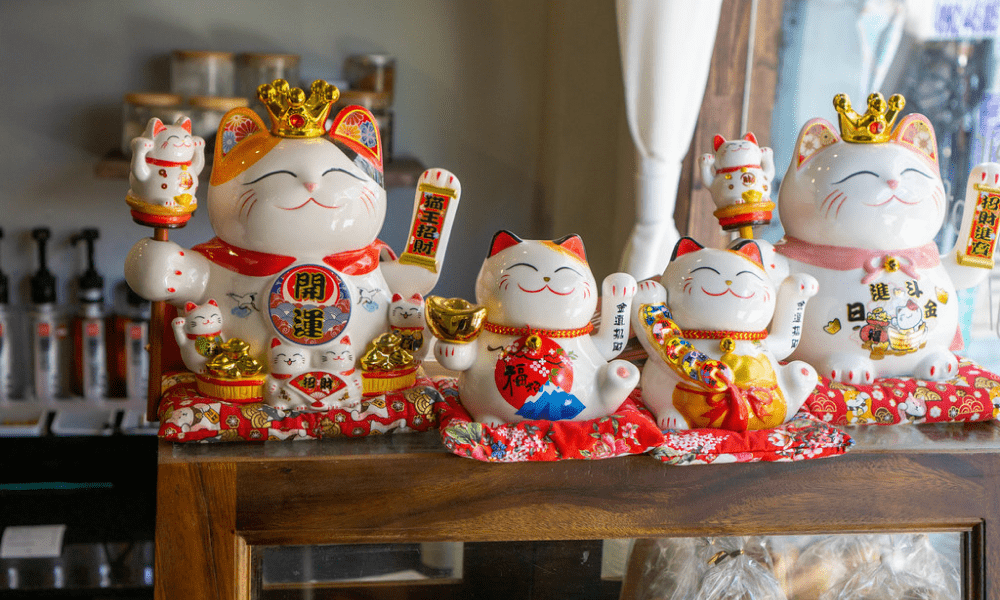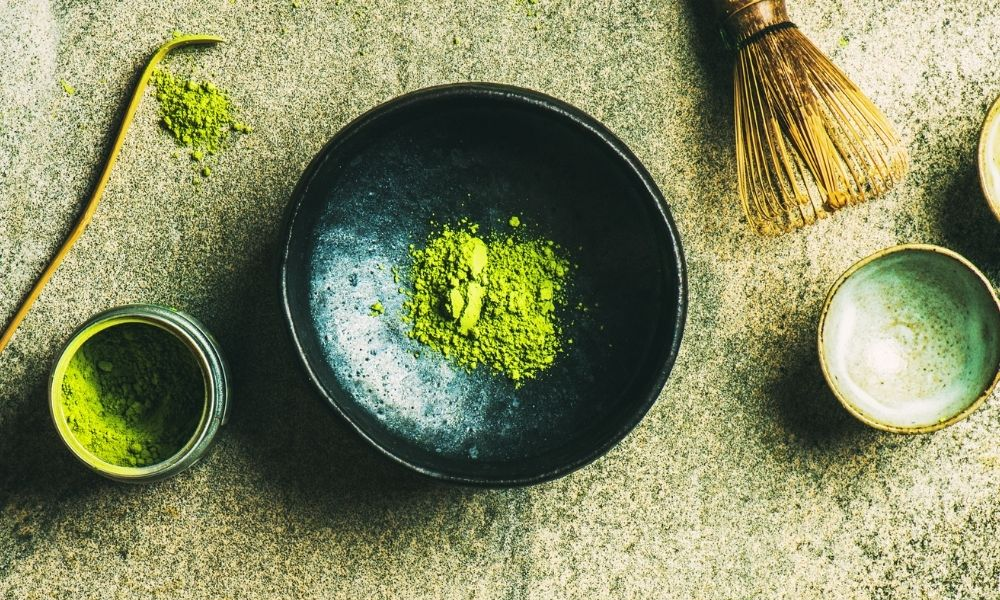Why You Should Buy Lucky Maneki-neko: Japan’s Icon of Luck & Prosperity
Maneki-neko, also known as the beckoning cat, is a symbol of good luck and prosperity in Japanese culture. Often referred to as lucky charm cats, these figurines are a staple in stores and homes, believed to bring wealth and attract customers. Originating from a tale in the Edo period 1603-1868, where a cat saved a shop owner’s life, leading to good fortune. These statues, with their strong traditional roots, deeply connect to the origin of Maneki-neko.

Each Maneki-neko has unique features, like a raised right paw for attracting money. Commonly known as the lucky cat money cat, or a left paw for drawing in people, symbolizing different blessings. Their colors carry significant meanings – white for happiness and good health, black to ward off evil spirits, and gold for wealth. Some Maneki-neko even hold items, such as a gold coin, to enhance financial luck.
Maneki-neko’s popularity has grown worldwide, including restaurants and shops reflecting a universal desire for good fortune. These cat figurines, which often resemble the Japanese bobtail, evolved into a blend of cultural tradition and modern art. This evolution represents a mix of historical beliefs and trends, making them a cherished symbol across different cultures.
Cincinnati’s Lucky Cat Museum and the Maneki-neko Museum of Art display various types of Maneki-neko. In the city of Aichi Prefecture, one can even see Maneki-neko statues and Cat Statues. It symbolizes the belief in these cats to bring good fortune and luck and fortune. Utagawa Hiroshige, a famous artist, contributed to popularizing the image of these fortune cats in Japan.
Here, we explore the history and Why You Should Buy Lucky Maneki-neko Cats and the meanings associated with its different elements.
The Significance of Maneki-neko’s Paw, Color, and Accessories

The Maneki-neko, a charming and symbolic figure in Japan, appears in diverse styles, each carrying distinct meanings. We’ll explore the intriguing symbolism behind its various features such as common colors.
Paw
The most defining feature of the Maneki-neko is its paw. Typically, a Maneki-neko figurine will have one paw raised. The lifted paw determines its meaning:
Right Paw
This position signals attracting financial wealth and prosperity. The right paw associates with money and positive financial transactions.
Left Paw
The left paw raised invites people and customers as a gesture. This symbolizes warmth and customer attraction, focusing on social connections and business growth rather than direct financial gains.
These interpretations contribute to the Maneki-neko’s status as a symbol of good fortune and prosperity.
Some Maneki-neko figurines feature both paws raised, signifying the invitation of both wealth and people. However, this gesture can also resemble a surrender, which is why some people avoid it.
Additionally, the height to which the raised paw extends can vary. A “Teyaki” Maneki-neko, with its paw above the ear, attracts distant and greater fortune. Meanwhile, a “Teyane” Maneki-neko, with its paw below the ear, brings closer, smaller fortunes and happiness.
The History of Maneki-neko
To know more about why you should buy lucky maneki-neko cats. The Maneki-neko’s origin is unclear, but it has started in Japan’s Edo period. While there are different theories, here are some possible explanations for its creation:
Gotokuji Temple in Tokyo
One of the most popular legends traces the origin of Maneki-neko to the Gotokuji Temple in Tokyo. The story describes a priest’s lucky cat for saving his life guiding a samurai into a temple during a storm, saving him from lightning.
Grateful to the cat, the samurai became a patron of the temple, significantly improving its fortunes. This story about ji temple emphasizes themes of gratitude, divine intervention, and the mysterious bond between humans and animals.
Yoshiie-dera Temple in Kyoto
Another fascinating tale unfolds at the Yoshiie-dera Temple in Kyoto. A friar and his feline companion take refuge in a shrine. The cat stops an attack on a leader by warning.
Furthermore, this lucky act makes the lord support the temple, making it more important and rich. This story underscores the theme of fate and how seemingly small actions can lead to significant outcomes.
Chinese Influence
Earlier Chinese customs and beliefs might also have influenced the Maneki-neko’s concept. The Chinese adage that a cat washing its face predicts the arrival of guests. It could have contributed to the idea of a cat beckoning good fortune and visitors. This cross-cultural influence highlights the connectedness of Asian cultures and their shared symbolic language.
Symbolism and Popularity
During the Edo period, people widely recognized Maneki-neko as a symbol of good luck, prosperity, and business success. Artists and decorators frequently placed the figurine in homes and businesses to attract fortune and wealth.
Evolution and Spread
Over the centuries, Maneki-neko evolved in design and symbolism, reflecting changes in societal values and aesthetics. Its spread beyond Japan’s borders signifies its universal appeal, transcending cultural and land-based boundaries. Today, Maneki-neko is not just a Japanese cultural icon but a global symbol of luck and prosperity. Resonating with people from diverse backgrounds and culture differences.
While, the history of Maneki-neko is a rich tapestry woven from folklore, cultural interactions, and evolving symbolism. From its mysterious origins in ancient temples to its contemporary status as a global emblem of good luck. the Maneki-neko remains a fascinating and enduring aspect of cultural heritage. This little figurine, continues to captivate and charm people worldwide, embodying a timeless allure that transcends its humble beginnings.
Maneki-neko’s Cultural Significance

While Maneki-neko’s cultural significance as a symbol of good fortune remains strong in Japan. Nowadays, individuals worldwide cherish Maneki-neko statues. Their various colors and poses continue to have diverse meanings and interpretations.
To have money and friends, Maneki-neko can bring good luck and positive thinking. For more about Maneki-neko, consider visiting the “Maneki-neko Museum.” This museum, featuring over 5,000 Maneki-neko-related items, offers a fascinating exploration of the charm’s history, regional variations, and cultural significance.
Planning to visit Japan soon? Here’s what you should know – Japan Tax Free System Revision
Maneki-neko Museum: A Treasure Trove
The Maneki-neko Museum, holding over 5,000 items, is more than a display of different figurines. This is a tribute to the charm’s lasting allure and its progression throughout the years. The museum shows how different Japanese regions have uniquely designed their Maneki-neko. It also highlights the artistic creativity behind each piece, from traditional designs to modern interpretations. Aligning all reasons why people are justifying wh you should buy lucky Maneki-neko cats in Japan.
The transformation of Maneki-neko to a worldwide symbol of luck and wealth to a cultural sharing and change. Its widespread popularity reflects the universal human desire for fortune and happiness. As a cultural symbol, Maneki-neko keeps inspiring and connecting people globally, adding luck to their lives. Its raised paw, a simple but meaningful gesture, symbolizes hope and prosperity worldwide.









